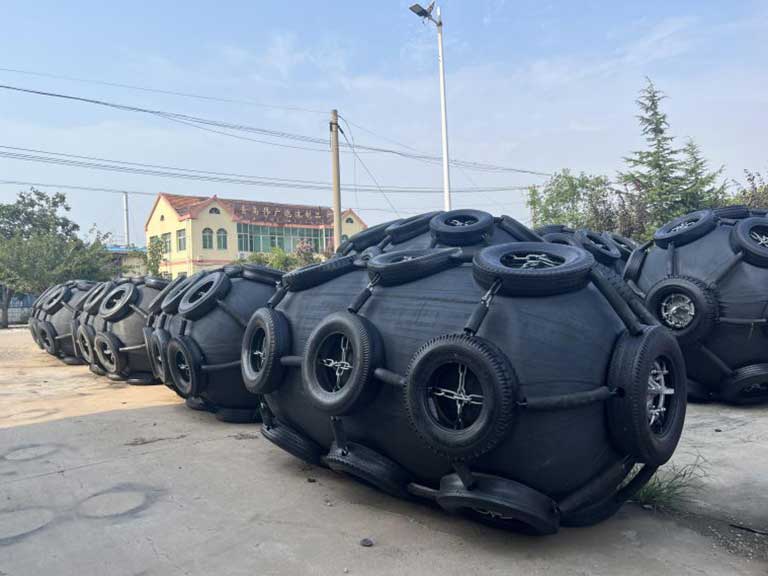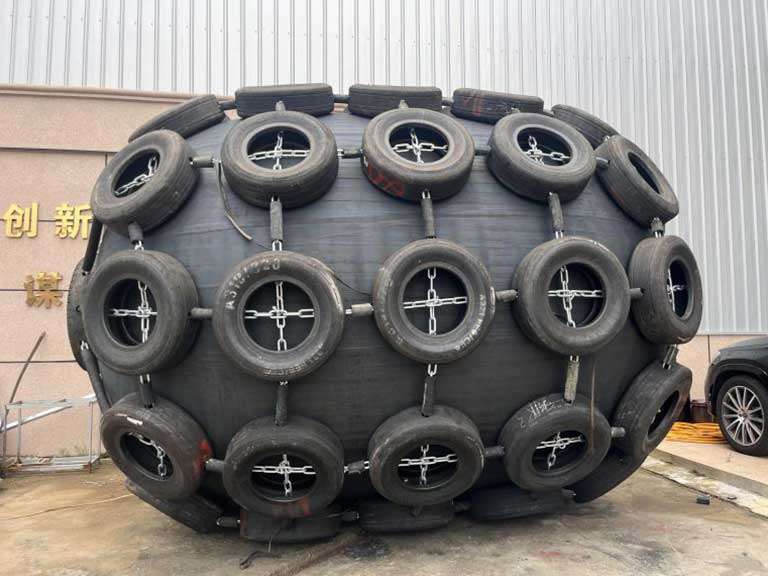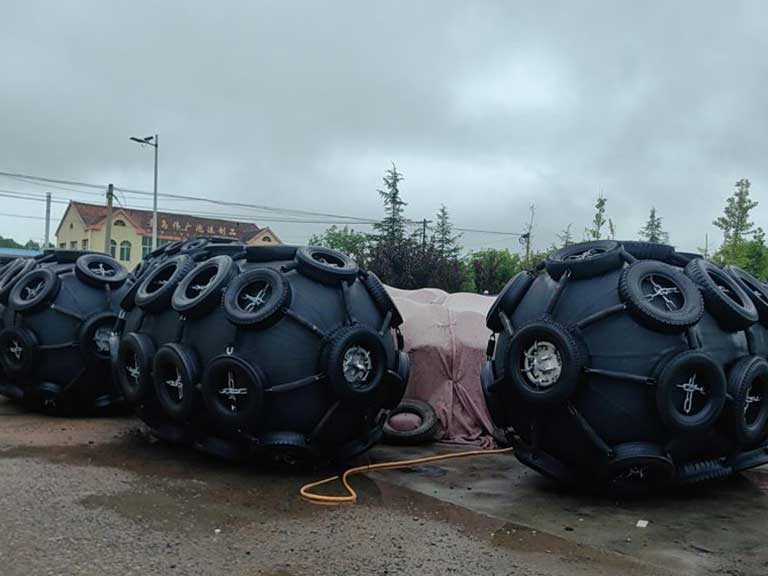رفرف يوكوهاما من شركة Henger Shipping Supplies، تُعد واقيات الصدمات البحرية من الحلول الرائدة عالميًا في مجال الحماية البحرية. تُستخدم على نطاق واسع في الموانئ والمراسي البحرية والمرافق البحرية. تتميز هذه الواقيات بمتانتها الفائقة وقدرتها العالية على تحمل الصدمات.
واقيات يوكوهاما هي أداة حماية قابلة للنفخ. تمتص بفعالية الصدمات بين السفن والأرصفة أو السفن الأخرى لضمان رسو آمن. تتكون هذه الواقيات من طبقات متعددة من مادة مطاطية قوية ومرنة. وهي مرتبة بزاوية مثالية، مما يساعد على توزيع الحمل والضغط بالتساوي. لتلبية مختلف الاحتياجات، تتوفر واقيات يوكوهاما بتشكيلة واسعة من الأحجام، ويمكن تعديلها لتناسب مختلف أنواع السفن والاحتياجات التشغيلية.
في الفقرات التالية، سنقدم المزيد من التفاصيل حول أحجام واقيات يوكوهاما. فهم هذه المعلومات سيساعدك على اتخاذ قرارات أكثر وعيًا، مما يضمن تلبية متطلبات الحماية للسفن والمرافق.
جدول المحتويات
فهم المصدات الهوائية من يوكوهاما
واقيات يوكوهاما، والمعروفة أيضًا باسم الواقيات الهوائيةهي أجهزة حماية بحرية متخصصة مصممة لامتصاص طاقة الصدمات أثناء عمليات إرساء السفن. تتكون هذه المصدات من هيكل مطاطي مقوى مملوء بالهواء المضغوط، مما يوفر نظام امتصاص صدمات فعال للغاية. وقد مثّل تطوير مصدات يوكوهاما إنجازًا هامًا في تعزيز السلامة البحرية أثناء عمليات الإرساء.
تاريخ وتطور المصدات الهوائية
تاريخ مصدات يوكوهاما يعود تاريخها إلى خمسينيات القرن الماضي. طوّرتها شركة يوكوهاما للمطاط المحدودة اليابانية، ومثّلت تحسّنًا كبيرًا على أساليب حماية الإرساء السابقة. قبل ظهور مصدات الهواء المضغوط، اعتمدت العمليات البحرية على حلول أقل فعالية، منها أساليب مرتجلة طرحت العديد من مشاكل السلامة والموثوقية.
يمنح التصميم القابل للنفخ مصدات الهواء الهوائية قدرة ممتازة على امتصاص الطاقة. كما يُحافظ على قوة رد فعل منخفضة نسبيًا على الهيكل، مما يُحسّن الحماية البحرية بشكل جذري. تعمل مصدات يوكوهاما بمبدأ ضغط الهواء. ينضغط الهواء المضغوط داخل الهيكل المطاطي عند الاصطدام، ممتصًا الطاقة الحركية للسفينة القادمة في الاتجاه المعاكس ومبددًا إياها.
أنواع واقيات يوكوهاما
تقدم هينجر مجموعة واسعة من واقيات الطين من يوكوهاماتلبي هذه المصدات متطلبات تشغيلية ومواصفات سفن متنوعة. صُممت مصداتنا لتوفير حماية مثالية لمختلف أحجام وأنواع السفن، مما يضمن عمليات إرساء آمنة.
واقيات الطين من النوع الشبكي (النوع الأول)يستخدم واقي الصدمات الشبكي شبكة واقية من إطارات السلسلة مغطاة بالمطاط. يتميز بمقاومة ممتازة للتآكل مع الحفاظ على خصائص امتصاص الطاقة المثلى. تتراوح أحجامه بين 300 مم × 600 مم و4500 مم × 12000 مم، مما يجعله مناسبًا لجميع أحجام السفن تقريبًا.
واقيات الطين من النوع Sling (النوع الثاني)تستخدم واقيات الصدمات من النوع Sling أنظمة حماية مختلفة، تشمل نتوءات مطاطية معززة وأجهزة رفع. هذا يجعلها مناسبة للتطبيقات ذات أسطح التلامس المتوقعة المختلفة. وهي متوفرة بنفس نطاق الأحجام الشامل لمصدات الصدمات من النوع Net.
أنواع خاصة وأحجام مخصصةللتطبيقات المتخصصة، نوفر أنواعًا متنوعة من واقيات الصدمات بأحجام مخصصة. تشمل هذه الواقيات واقيات الضغط المنخفض، والرفارف العمودية، والرفارف الهيدروليكية الهوائية. توفر هذه الحلول المصممة خصيصًا حمايةً مُصممة خصيصًا لظروف الإرساء الفريدة، مما يضمن سلامة السفن وكفاءة التشغيل.

ما هو حجم رفارف يوكوهاما؟
تقدم شركة هينجر لمستلزمات الشحن واقيات سفن صغيرة ومتوسطة وكبيرة وكبيرة جدًا. صُممت هذه الواقيات لتلبية احتياجات الحماية في مختلف الظروف. تتوفر الواقيات عادةً بأحجام تتراوح بين 500 مم و4500 مم في القطر، و1000 مم و12000 مم في الطول. يضمن هذا التنوع الواسع ملاءمتها للعديد من أنواع السفن والمراسي. بالإضافة إلى ذلك، توفر هينجر خيارات ضغط واقيات سفن هوائية بضغط 50 و80 كيلو باسكال.
كل حجم من مصدات يوكوهاما مناسب لمختلف السفن والاستخدامات. عادة ما تستخدم المصدات الصغيرة لرسو السفن الصغيرة أو الصنادل. المصدات متوسطة الحجم مناسبة لسفن الشحن متوسطة الحجم أو عمليات المحطات العامة. أما بالنسبة لسفن الحاويات الكبيرة أو عمليات الناقلات، فإن المصدات الكبيرة أو الكبيرة جدًا توفر حماية أفضل من التصادم.
في البيئات البحرية القاسية، كالحفر البحري، غالبًا ما تُعدّ مصدات السفن الكبيرة الخيار الأمثل، فهي قادرة على امتصاص الصدمات القوية وضمان التشغيل الآمن. يساعد اختيار الحجم المناسب لمصدات السفن على تحسين سلامة الموانئ والسفن، مما يقلل من خطر التلف ويضمن سلاسة عمليات السفن.
متطلبات الحجم في سيناريوهات التطبيق المختلفة
تتميز مصدات يوكوهاما بمتطلبات أحجام مختلفة لسيناريوهات الاستخدام المختلفة. يضمن هذا الحل المخصص السلامة في كل بيئة تشغيل. فيما يلي بعض سيناريوهات الاستخدام الشائعة:
الموانئ والمحطاتغالبًا ما تتطلب الموانئ والمراسي واقيات كبيرة عند رسوّ السفن الكبيرة. تمتص هذه الواقيات قوى التصادم الكبيرة، مما يمنع الاصطدامات المباشرة بين السفينة والرصيف. هذا يقلل من الأضرار التي تلحق بالسفينة ومرافق الرصيف. تتطلب السفن، مثل سفن الشحن الكبيرة وناقلات النفط وسفن الحاويات، هذه الواقيات الكبيرة لضمان السلامة عند الرسو.
العمليات القريبة من الشاطئللعمليات البحرية القريبة من الشاطئ، تُعدّ المصدات متوسطة الحجم خيارًا أفضل. تحتاج البارجات وقوارب العمل الصغيرة إلى حماية مناسبة لتجنب الاصطدامات عند الإبحار في المناطق القريبة من الشاطئ. توفر المصدات متوسطة الحجم امتصاصًا كافيًا للصدمات، كما أنها مرنة بما يكفي لاستخدامها في المناطق التي تكون فيها المساحة محدودة. فهي تضمن سلامة السفن عند الرسو، وخاصة في المياه الضيقة.
في الخارج اايل Dالطحنفي ظروف البحر الهائج، تحتاج منصات النفط البحرية إلى أعلى مستويات الحماية. توفر المصدات الكبيرة جدًا حماية فعّالة لهذه المنشآت الحيوية بفضل مقاومتها القوية للصدمات. عند مواجهة ظروف قاسية كالأمواج والعواصف، تُخفف المصدات الكبيرة من تأثير الصدمات. لذلك، تعمل المصدات الهوائية على تعزيز سلامة منصات حفر النفط البحريةوهذا يقلل من خطر تلف المعدات ويضمن التقدم السلس لعمليات الحفر.
لا يؤدي اختيار المصدات المناسبة إلى تحسين السلامة فحسب، بل يؤدي أيضًا إلى إطالة عمر السفينة ومرافق المحطة. إذا كانت هناك أي أسئلة حول اختيارك، يمكنك الاتصال بفريق هينجر مباشرةً للحصول على مشورة الخبراء.

كيفية اختيار الحجم المناسب لرفارف يوكوهاما
تُدرك هينجر أن اختيار المقاس المناسب لرفرف القارب أمرٌ بالغ الأهمية لحماية السفينة. فاختيار المقاس لا يؤثر فقط على قدرة الرفرف على امتصاص الصدمات، بل يؤثر أيضًا على سلامة القارب عند الرسو. لمساعدتك في اتخاذ القرار الصحيح، نوصي باتباع الخطوات التالية لاختيار مقاس رفرف القارب:
اعتمادا على حمولة السفينةتتطلب السفن الكبيرة واقيات أكبر، وذلك لقدرتها على امتصاص قوى الاصطدام القوية الناتجة عن رسوّ السفن. إذا كانت حمولة سفينتك كبيرة، فإن اختيار واقي كبير أو كبير جدًا سيوفر أفضل حماية.
خذ بعين الاعتبار زاوية الرسو:تؤثر زاوية رسو سفينتك أيضًا على توزيع قوى الاصطدام. إذا كانت سفينتك ترسو عادةً بزاوية أكبر، يُنصح باختيار حاجز حماية أكبر. ويعود ذلك إلى زيادة مساحة الحماية وضمان رسو أكثر أمانًا في كل مرة.
تقييم الظروف المناخيةفي البيئات القاسية كالبحر العاصف والهائج، وخاصةً في المنصات البحرية. توصي هينجر باستخدام مصدات أكبر لتحملها الصدمات القوية. هذا يضمن سلامة معداتك وسفينتك.
من خلال اتباع معايير الاختيار هذه، يمكنك ضمان أقصى قدر من الحماية لسفنك ومرافق الميناء الخاصة بك. وبدلاً من ذلك، اتصل بفريق خبرائنا ودعنا نقدم لك حلاً مصممًا خصيصًا لسفينتك.
الخاتمة
تتوفر واقيات يوكوهاما بأحجام وتصاميم متنوعة، وقد أصبحت من المعدات الأساسية لحماية السفن حول العالم، سواءً في الموانئ أو المنشآت الساحلية أو المشاريع البحرية. تمتص هذه الواقيات الصدمات وتحمي السفن.
يضمن اختيار المقاس والتصميم المناسبين السلامة في مختلف الظروف. كما يُجنّب تلف المرافق، مما يُقلّل تكاليف الصيانة. يُقدّم فريق هينجر تشكيلةً واسعةً من مقاسات أجنحة يوكوهاما. إذا كانت لديكم أي اقتراحات، يُمكنكم التواصل مع فريقنا مباشرةً للحصول على مساعدة احترافية.

الأسئلة الشائعة
ما هي العوامل الرئيسية التي يجب مراعاتها عند اختيار الحاجز الهوائي لسفينتي؟
عند اختيار مصدات القوارب القابلة للنفخ، يجب مراعاة عوامل مثل حجم ونوع السفينة، واستهلاك طاقة الإرساء، والظروف البيئية. هذا يضمن اختيار المصدات المناسبة لضمان سير سفينتك بأمان وكفاءة.
كيف يمكنني تحديد الضغط الأولي الصحيح لرفرفي الهوائي؟
إن الضغط الأولي للحواجز الهوائية يعتمد ذلك على حجمها ونوعها والمتطلبات الخاصة للسفينة. وهذا يضمن الأداء الأمثل والسلامة أثناء عمليات الإرساء.
ما هو الفرق بين المصدات الهوائية من النوع Net و Sling Type؟
تتميز مصدات الشبكة بطبقة خارجية تشبه الشبكة، بينما تستخدم مصدات الحبال حبالاً أو حبلاً لتثبيتها. يعتمد الاختيار بينهما على التطبيق المحدد ومتطلبات السفينة.
كم مرة يجب علي إجراء فحوصات الصيانة على الرفارف الهوائية الخاصة بي؟
صيانة المصدات الهوائية يجب أن تُجرى الصيانة وفقًا لإرشادات الشركة المصنعة. وتشمل هذه الفحوصات عادةً فحص الضغط والتأكد من عدم وجود أي تلف أو تآكل. هذا يضمن بقاء رفرف السيارة في حالة جيدة.
هل يمكن استخدام المصدات الهوائية في الظروف الجوية القاسية؟
صُممت مصدات الهواء المضغوط للعمل في ظروف بيئية متنوعة. ومع ذلك، قد يتأثر أداؤها بالظروف الجوية القاسية. نوصي بمراعاة هذه العوامل أثناء عملية الاختيار لضمان الأداء الأمثل.
ما هي فوائد استخدام المصدات الهوائية مقارنة بأنواع المصدات الأخرى؟
تتميز مصدات الهواء المضغوط بقدرة ممتازة على امتصاص الطاقة، ومرونة عالية، ومتانة فائقة. هذا يجعلها خيارًا موثوقًا لحماية السفن أثناء عمليات الرسو والإرساء.
هل هناك أي معايير ISO محددة يجب أن تتوافق معها المصدات الهوائية؟
نعم، يجب أن تتوافق مصدات الرياح القابلة للنفخ مع معيار ISO 17357. يحدد هذا المعيار متطلبات مصدات الرياح القابلة للنفخ المستخدمة في التطبيقات البحرية، مما يضمن استيفائها لمعايير السلامة والأداء الدولية.




